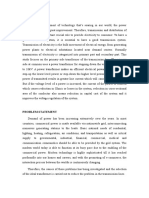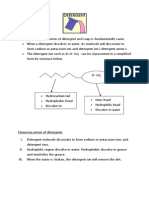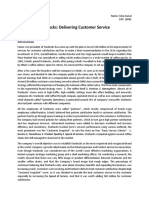0 ratings0% found this document useful (0 votes)
5K viewsConclusion
Conclusion
Uploaded by
Roshni Khan1. Urbanization in developing countries initially led to higher mortality rates in urban areas due to overcrowding and poor sanitation. However, recent evidence shows that urban areas now have lower mortality rates than rural areas due to greater concentration of medical facilities.
2. Cities have historically been centers of innovation and socioeconomic development. They power national economic growth through agglomeration economies.
3. Urbanization generally contributes to lower population growth as urban lifestyles encourage smaller families, higher education levels, and increased contraceptive use.
Copyright:
© All Rights Reserved
Available Formats
Download as PDF, TXT or read online from Scribd
Conclusion
Conclusion
Uploaded by
Roshni Khan0 ratings0% found this document useful (0 votes)
5K views4 pages1. Urbanization in developing countries initially led to higher mortality rates in urban areas due to overcrowding and poor sanitation. However, recent evidence shows that urban areas now have lower mortality rates than rural areas due to greater concentration of medical facilities.
2. Cities have historically been centers of innovation and socioeconomic development. They power national economic growth through agglomeration economies.
3. Urbanization generally contributes to lower population growth as urban lifestyles encourage smaller families, higher education levels, and increased contraceptive use.
Original Description:
Good
Copyright
© © All Rights Reserved
Available Formats
PDF, TXT or read online from Scribd
Share this document
Did you find this document useful?
Is this content inappropriate?
1. Urbanization in developing countries initially led to higher mortality rates in urban areas due to overcrowding and poor sanitation. However, recent evidence shows that urban areas now have lower mortality rates than rural areas due to greater concentration of medical facilities.
2. Cities have historically been centers of innovation and socioeconomic development. They power national economic growth through agglomeration economies.
3. Urbanization generally contributes to lower population growth as urban lifestyles encourage smaller families, higher education levels, and increased contraceptive use.
Copyright:
© All Rights Reserved
Available Formats
Download as PDF, TXT or read online from Scribd
Download as pdf or txt
0 ratings0% found this document useful (0 votes)
5K views4 pagesConclusion
Conclusion
Uploaded by
Roshni Khan1. Urbanization in developing countries initially led to higher mortality rates in urban areas due to overcrowding and poor sanitation. However, recent evidence shows that urban areas now have lower mortality rates than rural areas due to greater concentration of medical facilities.
2. Cities have historically been centers of innovation and socioeconomic development. They power national economic growth through agglomeration economies.
3. Urbanization generally contributes to lower population growth as urban lifestyles encourage smaller families, higher education levels, and increased contraceptive use.
Copyright:
© All Rights Reserved
Available Formats
Download as PDF, TXT or read online from Scribd
Download as pdf or txt
You are on page 1of 4
CONCLUSION
1. Urbanization generally contributes to the lowering of population
fertility rates and average family sizes. This is largely a result of
the behavioural and lifestyle changes which characterize
urbanization, including better education, higher age at first
marriage, increased female employment and higher rates of
contraceptive use. In addition, the cost of caring for the diverse
needs of children, combined with the desire for improved living
conditions and higher quality of life, tends to discourage urban
residents from having large families. This conclusion is supported
by evidence from both developed and developing countries.
2. Evidence on mortality suggests that in developed countries,
urbanization initially led to higher mortality rates in urban than in
rural areas, largely due to severe overcrowding, combined with
very bad sanitation conditions. At present, there is hardly any
difference between urban and rural mortality rates in developed
countries. However, recent evidence from developing countries
suggests that urban areas have lower mortality rates than rural
areas. This is largely a result of the greater concentration of
medical facilities within urban areas.
3. With regard to general socio-economic development, it is very
clear from historical evidence that cities and towns are both the
loci and agents of innovation, innovation diffusion and socio-
economic transformation. The history of scientific and
technological innovation, and that of civilization in general, is
inseparable from that of towns and cities. Among the significant
manifestations of most of the ancient civilizations were their towns
and cities.
4. Worldwide empirical evidence demonstrates clearly that there
is a positive correlation between GNP per capita and level of
urbanization (measured as the percentage of the total national
population resident within urban areas). It is generally recognized
that towns and cities are the engines of national economic growth,
largely as a result of the agglomeration economies which
characterize them.
5. At the household level, the net effect of urbanization is an
increase in average real income. For individuals and their
households, urban areas offer better opportunities of income
generation, whether through formal employment or through
informal sector activities. It is also clear that expectation of higher
incomes is the main factor underlying rural-to-urban migration in
developing countries.
6. Finally, evidence from developing countries suggests that
urban centres have many positive impacts on their rural
hinterlands through a variety of urban-rural linkages. These
linkages include: remittances of money by urban residents to their
rural kin; transfer of knowledge and skills through migrants
returning from urban to rural areas; and the provision of retail,
transport, social and administrative services to rural hinterland
populations.
Historical experience suggests that urbanization is an inevitable
process. In light of this observation, combined with the positive
impacts or urbanization outlined above, it is clear that the main
challenge at present is not that of slowing-down urbanization, but
of learning how to cope with rapid urban growth. In recognition of
the role of cities as engines of economic development, there has
recently been a resurgence of interest in urban management as
the main tool for coping with rapid urban growth and maximising
the positive demographic and socio-economic impacts of
urbanization
Although there is quite a sizeable literature pertaining to urban policies,
urbanization, and urban planning in Malaysia, most of it deals with the
local, regional, or national perspective, and the international dimensions
pertinent to the evolution of the national urban system have been largely
ignored.
Over the past three decades (1960-1990), Malaysia has seen a
tremendous social and economic transformation. In the 1960s, the initial
efforts at import substitution in industrial policy had begun to provoke
the movement of people from rural areas to urban centres. In the 1970s,
especially with the change in strategy to export-oriented industries, the
country enjoyed a comparatively high rate of economic growth even
though it was a time when primary commodities were subject to extra-
national shocks. The nature of the country's economy had also begun to
adjust to a realignment with international dealings as transnational flows
of goods, services, capital, labour, and technology expanded quickly.
Although the 1980s are often described as a "lost decade" for the
developing countries (Karaosmanoglu, 1991), Malaysia had a rapidly
industrializing economy. In other words, the many policy adjustments
introduced in the 1980s in response to the changing world economy have
been successful. However, policy adjustments such as enhancing the role
of the private sector in generating economic growth; the privatization of
government agencies and selected services; greater emphasis on the
development of export-oriented industries and urban growth centres; and
the people-prosperity strategy have led to greater urbanization in a few
selected nodes, in particular the Kuala Lumpur Core Urban Region
(KLCUR) - the main urban settlements in and around the Klang Valley,
including its immediate "umbra!" hinterland. The unprecedented growth
of KLCUR has important ramifications for other urban areas, the rural
areas, as well as the lagging areas, all of which need to be studied in the
light of the continued globalization of the Malaysian economy.
It is the intention of this chapter to examine the process of urbanization
in Malaysia and analyse how the patterns of internationalization of the
economy have led to the further accentuation of existing primal and
macrocephalic tendencies in the urban system. Focusing on KLCUR,
this chapter highlights the locational predilection of selected global
economic activities, their spatial implications, and eventual effect on
urban services and infrastructure. The irony of this is that what initially
attracted and accelerated the globalization process may eventually erode
the competitiveness of these very services and goods, which may then
lead to a reduction in labour absorption and unemployment.
The nature and trends of the national urban system
Definition of urban population
The population censuses in Malaysia define "urban" as "gazetted areas"
with a minimum population of 10,000. The term "gazetted area" refers to
a local administrative unit with clearly defined boundaries (Malaysia,
1983). The 1970 and 1980 censuses also classified urban areas into three
categories: "metropolitan," with a population in excess of 75,000; "large
town," with a population size of 10,000 and over; and "small town," with
a population size of 1,000 to 9,999 persons. "Small towns," however, are
excluded from the consideration of urbanization levels. Based on this
definition, there are 14 metropolitan areas, and 53 towns with a
population of 10,000 to 75,000 (fig. 10.1)
Undoubtedly, there are problems associated with such a methodology
and these difficulties have been discussed by Lee (1977) and Aziz
Othman (1988). A good example is the reclassification of the local
authority areas conducted in 1976. Before 1976, local authority areas
were classified into five categories: municipality, town council, town
board, local council, and new village. From 1976 onwards, they were
reclassified into two categories: municipal council and district council.
This regrouping has led to some 12 urban centres with their boundaries
extended to incorporate neighbouring local authority areas. For example,
in 1972 Kuala Lumpur annexed Jinjang, which had a population of more
than 27,000.
You might also like
- Effect of Population Growth On Transportation Facilities in NigeriaDocument32 pagesEffect of Population Growth On Transportation Facilities in NigeriaGabriel Haruna100% (6)
- Civilian and SoldierDocument2 pagesCivilian and SoldierIvan Hernandez71% (7)
- Waste Management ProjectDocument42 pagesWaste Management ProjectNeha Sharma100% (1)
- Business and SocietyDocument111 pagesBusiness and SocietyRizu Mi50% (4)
- ProposalDocument31 pagesProposalElisante David100% (3)
- Training Report at PUBLIC HEALTH ENGINEERING (PHE)Document46 pagesTraining Report at PUBLIC HEALTH ENGINEERING (PHE)rockingshyamal00789% (9)
- QUESTIONNAIRE For FLOOD AFFECTEDSDocument3 pagesQUESTIONNAIRE For FLOOD AFFECTEDSRájDèép Trìpâţhí100% (3)
- Introduction, Problem Statement & ObjectiveDocument2 pagesIntroduction, Problem Statement & ObjectiveAfiq Nasrullah100% (8)
- PPT On FloodDocument24 pagesPPT On FloodjinterpaulNo ratings yet
- Tour ReportDocument27 pagesTour Reporthimanshu6786No ratings yet
- Survey Questions: UrbanizationDocument3 pagesSurvey Questions: Urbanizationkanwalmaria100% (2)
- Slum ChildrenDocument12 pagesSlum ChildrenjanithaNo ratings yet
- Public Speech. The Importance of Financial Literacy in SchoolsDocument2 pagesPublic Speech. The Importance of Financial Literacy in SchoolsSaule Janonyte100% (1)
- Importance of Statistics in Different FieldsDocument2 pagesImportance of Statistics in Different FieldsAshley Causy100% (3)
- Research 3-5-20Document33 pagesResearch 3-5-20Dan Louie Jubay100% (1)
- Writing A Research ProposalDocument14 pagesWriting A Research Proposalkate denoyaNo ratings yet
- Technology A Boon or A Bane Ojas - Eng - FinalDocument12 pagesTechnology A Boon or A Bane Ojas - Eng - FinalOjas100% (1)
- Survey Questionnaire (Bped 1-b)Document3 pagesSurvey Questionnaire (Bped 1-b)research extension0% (1)
- Literature Review - RiverDocument12 pagesLiterature Review - Riveruyunaman100% (2)
- Rape SpeechDocument3 pagesRape SpeechJayniacJaynerdNo ratings yet
- Poor Road Conditions in Barangay Libjo, Batangas CityDocument9 pagesPoor Road Conditions in Barangay Libjo, Batangas CitySharmaine Lopez100% (1)
- 1000 Word Essay About Global WarmingDocument3 pages1000 Word Essay About Global WarmingJean Romero100% (2)
- Literature ReviewDocument5 pagesLiterature Reviewapi-285103308100% (1)
- Role of Education in Social Mobility: M.Ed CourseDocument11 pagesRole of Education in Social Mobility: M.Ed CourseSourav Sweet100% (1)
- Reflection On Child LaborDocument5 pagesReflection On Child LaborKatherine 'Chingboo' Leonico Laud100% (1)
- Cleansing Action of DetergentDocument5 pagesCleansing Action of DetergentMisratul A'la Mahyuddin60% (5)
- Conclusion RecommendationDocument2 pagesConclusion RecommendationNicole Anne Borromeo67% (3)
- S.W.O.T. Analysis SampleDocument2 pagesS.W.O.T. Analysis SampleCALLENo ratings yet
- Street Vendors Project Verified FinalDocument73 pagesStreet Vendors Project Verified Finalshivaraj gowdaNo ratings yet
- Waste ManagementDocument53 pagesWaste ManagementBenison Mathew100% (1)
- Literature Review (Etp)Document4 pagesLiterature Review (Etp)Beman Easy100% (4)
- Scope and LimitationsDocument9 pagesScope and Limitationsmark_som100% (1)
- Question NairDocument4 pagesQuestion NairJaisurya SharmaNo ratings yet
- Chapter Four: 4.0 Data Presentation and Analysis 4.1Document8 pagesChapter Four: 4.0 Data Presentation and Analysis 4.1Abdulsamad100% (1)
- EVS So Studies CurriculumDocument118 pagesEVS So Studies CurriculumPranay PandeyNo ratings yet
- Speech On Social Media - A Boon or A CurseDocument3 pagesSpeech On Social Media - A Boon or A CurseKritika Upadhyay100% (2)
- The Role of The Mass MediaDocument2 pagesThe Role of The Mass Mediaflowerpluck100% (1)
- Socio Economic Survey of VillageDocument28 pagesSocio Economic Survey of Villageayush0anand-20% (1)
- Mid Day Meal Scheme Kamini Shankar B.Ed 1styr MDDocument4 pagesMid Day Meal Scheme Kamini Shankar B.Ed 1styr MDKamini Shankar100% (1)
- Slums: Causes and SolutionDocument10 pagesSlums: Causes and SolutionJanvi SorenNo ratings yet
- 11th & 12th GeneralStudies - SrSec - 2024-25Document71 pages11th & 12th GeneralStudies - SrSec - 2024-25Himalaya Int. RatlamNo ratings yet
- Is Science A Boon or BaneDocument3 pagesIs Science A Boon or BaneRANI67% (3)
- Misuse of TechnologyDocument2 pagesMisuse of Technologymohammed80% (5)
- Water Supply Engineering PPT. Reaz 1Document28 pagesWater Supply Engineering PPT. Reaz 1Mrinmoyee Nasreen100% (2)
- NCSC Questionnaire For SurveyDocument3 pagesNCSC Questionnaire For Surveysrikant panigrahiNo ratings yet
- Essay On Population ExplosionDocument16 pagesEssay On Population ExplosionManik ChoudharyNo ratings yet
- The Aims and Objectives of Teaching Geography and Political Science at The Secondary Level AreDocument2 pagesThe Aims and Objectives of Teaching Geography and Political Science at The Secondary Level AreVijina CpNo ratings yet
- The Development Contributions of The Sangguniang Kabataan Officials The Case of Barangay Cawayan Linuk, Marantao, Lanao Del SurDocument9 pagesThe Development Contributions of The Sangguniang Kabataan Officials The Case of Barangay Cawayan Linuk, Marantao, Lanao Del SurJournal of Interdisciplinary PerspectivesNo ratings yet
- Resettlement and Rehabilitation of People: Its Problems and ConcernsDocument3 pagesResettlement and Rehabilitation of People: Its Problems and ConcernsGourab100% (1)
- Data Analaysis and InterpretationDocument56 pagesData Analaysis and Interpretationporkodisvl100% (2)
- Generation Gap (Research Report Writing)Document30 pagesGeneration Gap (Research Report Writing)Sumbal91% (11)
- Solid Waste Management PDFDocument8 pagesSolid Waste Management PDFNagendra Babu Naidu100% (1)
- Projet Report Flash Flood of UttarakhandDocument20 pagesProjet Report Flash Flood of UttarakhandDiyasha GangulyNo ratings yet
- Importance of Co EducationDocument2 pagesImportance of Co EducationMary Hope Bacuta100% (1)
- Human Geo NotesDocument86 pagesHuman Geo NotesHenry Ndungu100% (1)
- Disaster ManagementDocument33 pagesDisaster ManagementNeha Mittal50% (2)
- Scope and Importance of Environmental StudiesDocument5 pagesScope and Importance of Environmental Studiesonline classes75% (4)
- Questionnaire On Youth and TechnologyDocument2 pagesQuestionnaire On Youth and TechnologyMasunji Emanuel0% (1)
- 1623399909Document9 pages1623399909youthhub852No ratings yet
- A Review of The Main Challenges To Urban Sustainability (Keivani, 2010)Document13 pagesA Review of The Main Challenges To Urban Sustainability (Keivani, 2010)Ato ArthurNo ratings yet
- Problems of Industrialization and UrbanizationDocument61 pagesProblems of Industrialization and UrbanizationKaran singhNo ratings yet
- Starbucks: Delivering Customer Service: SummaryDocument1 pageStarbucks: Delivering Customer Service: SummaryZoha KamalNo ratings yet
- Changes in Existing Decommissioning, Restoration and Similar LiabilitiesDocument3 pagesChanges in Existing Decommissioning, Restoration and Similar LiabilitiesTess De LeonNo ratings yet
- E3sconf Netid2021 02032Document7 pagesE3sconf Netid2021 02032prabathnilanNo ratings yet
- Zakat - Calculation SheetDocument24 pagesZakat - Calculation SheetMuhammad Nadeem SheikhNo ratings yet
- RRL LawsDocument2 pagesRRL LawsSarah LeeNo ratings yet
- MGT AssignmentDocument2 pagesMGT AssignmentRio AwitinNo ratings yet
- Unit 1Document7 pagesUnit 1Abhishek UpadhayaNo ratings yet
- Finance For ExecutivesDocument9 pagesFinance For ExecutivesFreiestrasseNo ratings yet
- Case 1Document2 pagesCase 1Brian GoNo ratings yet
- Structured Finance - Session 1Document19 pagesStructured Finance - Session 1eloi.ganierNo ratings yet
- Supply Chain ScorecardDocument4 pagesSupply Chain ScorecardbumbiazarkaNo ratings yet
- Successfully Navigating The Turbulent Skies of A Large-Scale ERP ImplementationDocument2 pagesSuccessfully Navigating The Turbulent Skies of A Large-Scale ERP ImplementationRizky ShiddiqyNo ratings yet
- Introduction of Company:: LOOCUST INCORP APPAREL PRIVATE LIMITED's Corporate Identification Number Is (CIN)Document24 pagesIntroduction of Company:: LOOCUST INCORP APPAREL PRIVATE LIMITED's Corporate Identification Number Is (CIN)Cromp TonNo ratings yet
- Scrapbook by Group 4Document34 pagesScrapbook by Group 4Danilo Botero Jr.No ratings yet
- PTDDocument6 pagesPTDejazdar89No ratings yet
- Solid Waste ManagementDocument4 pagesSolid Waste ManagementHritik MhatreNo ratings yet
- Comparative Performance of PPPs and Traditional Procurement Project in IndonesiaDocument19 pagesComparative Performance of PPPs and Traditional Procurement Project in IndonesiaawasesoNo ratings yet
- Case DiscussionsDocument3 pagesCase DiscussionsCharanmadhav KorrapatiNo ratings yet
- Placement Reports SIESDocument3 pagesPlacement Reports SIESNeel ShahNo ratings yet
- Digitalization of Securities MarketDocument8 pagesDigitalization of Securities Marketmrinal kumarNo ratings yet
- Delivering Infrastructure at Scale:: Ethekwini Water and Sanitation Experience in A Pilot ProjectDocument7 pagesDelivering Infrastructure at Scale:: Ethekwini Water and Sanitation Experience in A Pilot ProjectRon WatermeyerNo ratings yet
- The Cost of Capital: Sources of Capital Component Costs Wacc Adjusting For Flotation Costs Adjusting For RiskDocument37 pagesThe Cost of Capital: Sources of Capital Component Costs Wacc Adjusting For Flotation Costs Adjusting For RiskMohammed MiftahNo ratings yet
- Nike Pestel AnalysisDocument9 pagesNike Pestel AnalysisRania MarshaNo ratings yet
- The Secret CurrencyDocument12 pagesThe Secret CurrencyDavid de LafuenteNo ratings yet
- Rishabh Rohit Motiwala-7001Document1 pageRishabh Rohit Motiwala-7001Suryakiran kallaNo ratings yet
- Ipo Performance in India: January 2013Document13 pagesIpo Performance in India: January 2013Sai VarunNo ratings yet
- Acc 1Document3 pagesAcc 1Nitish YadavNo ratings yet
- Entrep Mind Module 6Document10 pagesEntrep Mind Module 6Wynnie RondonNo ratings yet
- Quess Corp Limited Head Office 3/3/2, Amblipura, Bellandur Gate, Sarjapur Road, Bengaluru, Karnataka 560103Document1 pageQuess Corp Limited Head Office 3/3/2, Amblipura, Bellandur Gate, Sarjapur Road, Bengaluru, Karnataka 560103AnshumanNo ratings yet

























































































